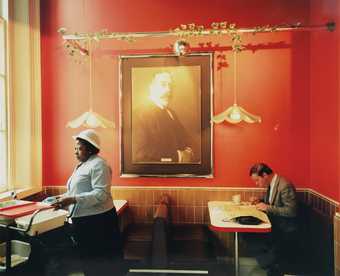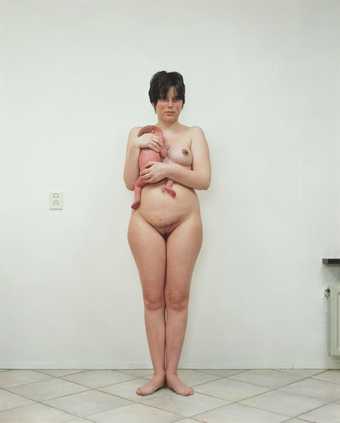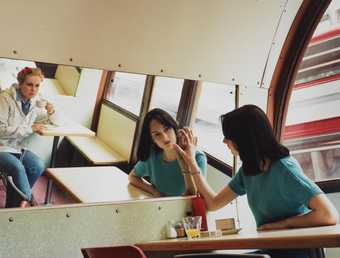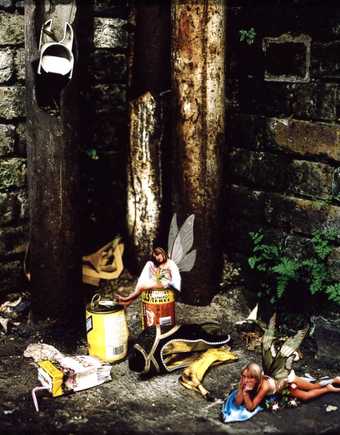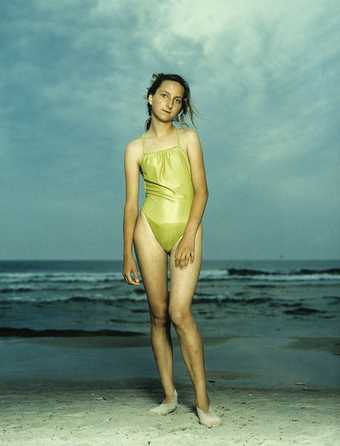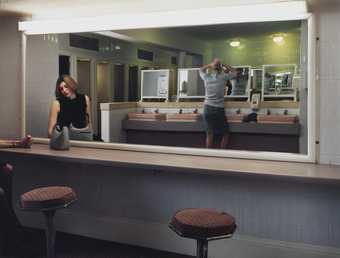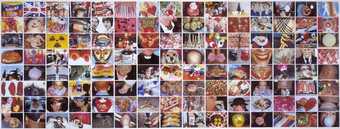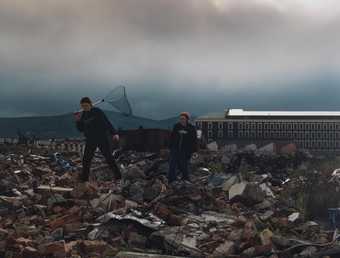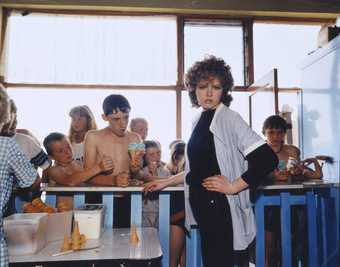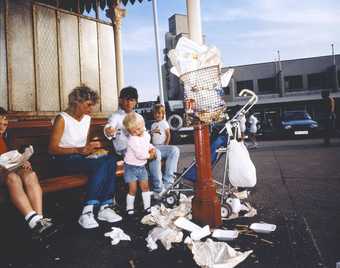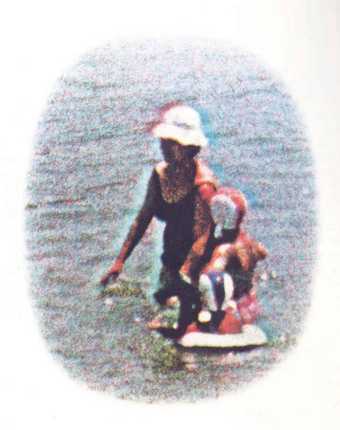
Not on display
- Artist
- Martin Parr CBE born 1952
- Medium
- Photograph, inkjet print on paper, mounted on aluminium
- Dimensions
- Frame: 1057 × 1310 × 50 mm
image: 1000 × 1250 mm - Collection
- Tate
- Acquisition
- Presented by the artist and Rocket Gallery 2002
- Reference
- P11922
Summary
The Last Resort is a series of forty photographs taken in New Brighton, a beach suburb of Liverpool. Shot with a medium format camera and daylight flash, the photographs are an early example of Parr’s characteristic saturated colour, influenced by the American colour photography of William Eggleston (born 1939) and Garry Winogrand (1928-84). Parr printed eleven images from The Last Resort in a large-format edition of five for his 2002 retrospective at the Barbican Art Gallery, London. New Brighton, Merseyside (40) is one of four works from this special edition owned by Tate.
The photographs comprising The Last Resort were taken between 1983 and 1985, a period of economic decline in northwest England. They depict a seaside resort past its prime with attractions designed to appeal to an economically depressed working class: overcrowded beaches, video arcades, beauty competitions, tea rooms and chip shops. The series was exhibited at the Serpentine Gallery, London and published as a book in 1986, and was instrumental in establishing Parr’s reputation as a photographer. Traditionally, documentary photography in Britain sought to glorify the working class; here Parr shows a warts-and-all picture of a down-at-heel resort populated by day trippers seeking cheap thrills. The series contains many images of people dressed in the day-glo lycra fashions of the time, eating junk food in the crumbling remains of a seaside town.
In the 1980s The Last Resort was seen as an indictment of the market-led economic policies of the Conservative government led by Margaret Thatcher (Prime Minister 1979-90). Some critics understood Parr’s depiction of an area of economic deprivation and his focus on his subjects’ personal indulgences as a political statement decrying the excesses of Thatcherism. More recently, in her monograph on Parr, Val Williams has proposed a less political reading of the pictures. In her view, The Last Resort typifies Parr’s incisive eye for the eccentric. She has commented, ‘There’s no cynicism in Parr’s gaze, just interest, excitement and a real sense of the comedic’ (Williams, p.161). Parr himself has claimed, ‘I’m less interested in the fact that these people aren’t well off financially as in the fact that they have to deal with screaming kids, like anyone has to ... I’m also interested in making the photographs work on another level, showing how British society is decaying; how this once great society is falling apart’ (quoted in Williams, p.160).
In this image, a woman with heavily freckled shoulders is sunbathing face down on a white towel. Her face is turned away from the camera, and her red hair pinned with a series of plastic combs. Her young daughter crouches nearby, her pink swimsuit tied round her neck with a bright blue bow. She appears to be playing with a red plastic bucket. Other buckets and a spade lie in the foreground of the picture, denoting a family day out at the seaside. The ordinariness of the scene is undermined by the unintentionally comical location of the family on a patch of concrete right in front of a large piece of haulage machinery, possibly a crane. Huge tank-like wheels loom over the reclining figure.
A low wall intersects the picture plane, separating the family from a path leading to the water. In their isolated enclave, picked out with the bright synthetic colours of the buckets and a discarded pair of red jelly shoes, they seem oblivious to the comedy of their situation. Beyond the wall, an older man wanders by; he too ignores the surreal quality of the scene. In contrast to the young mum and daughter, he is dressed drably in brown jacket and trousers. His hands are clasped behind his back, a grey plastic bag swinging from his arm.
The scene suggests a futuristic wasteland where families share beach space with industrial machinery, and this, as much as the flourescent colours of the toys, gives it a recognisably 1980s aesthetic: science-fiction films of the period conveyed a sense of post-industrial apocalyptic dread that this image seems to gently satirise. Here the machine is neither aggressive nor benign; it is simply part of the landscape.
Further reading:
Martin Parr and Ian Walker, The Last Resort: Photographs of New Brighton, Stockport, 1986, reproduced no.40 in colour.
Val Williams, Martin Parr, London, 2002, reproduced p.195 in colour.
Rachel Taylor
September 2003
Does this text contain inaccurate information or language that you feel we should improve or change? We would like to hear from you.
Explore
- emotions, concepts and ideas(16,416)
-
- formal qualities(12,454)
-
- photographic(4,673)
- recreational activities(2,836)
-
- sunbathing(54)
- clothing and personal items(5,879)
-
- swimming costume(102)
- towel(42)
- spade(4)
- bucket(111)
- girl(1,079)
- UK cities, towns and villages(12,725)
-
- New Brighton(12)
- Wirral(12)
- England(19,202)
- health and welfare(696)
-
- poverty(153)
- urban environment(303)
- contemporary society(640)
You might like
-
Martin Parr CBE Hyde Park, London
1971 -
Martin Parr CBE Brick Lane, London
1976 -
Martin Parr CBE King’s Cross Station, London
1990 -
Rineke Dijkstra Saskia, Harderwijk, Netherlands, March 16 1994
1994, printed 2021 -
Hannah Starkey Untitled - May 1997
1997 -
Mat Collishaw Sugar and Spice, All Things Nice, This Is What Little Girls Are Made Of #7
1998 -
Rineke Dijkstra De Panne, Belgium, August 7 1992
1992 -
Rineke Dijkstra Kolobrzeg, Poland, July 26 1992
1992 -
Hannah Starkey Untitled - March 1999
1999 -
Martin Parr CBE Common Sense
1995–9 -
Hannah Starkey Butterfly Catchers
1999 -
Martin Parr CBE The Last Resort 23
1983–6, printed 2018 -
Martin Parr CBE The Last Resort 25
1983–6, printed 2018 -
Martin Parr CBE The Last Resort 29
1983–6, printed 2002 -
Richard Hamilton Vignette
1969



